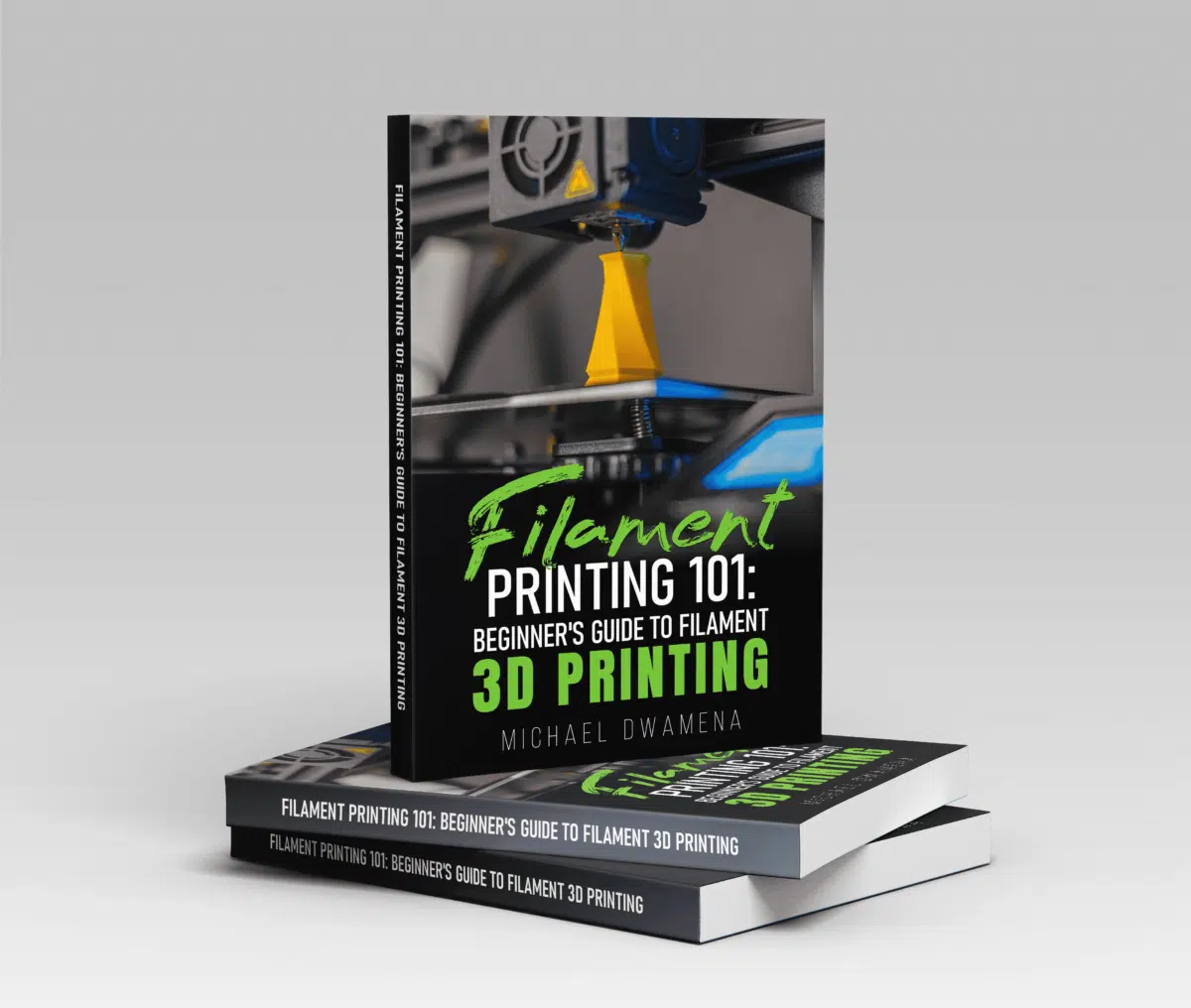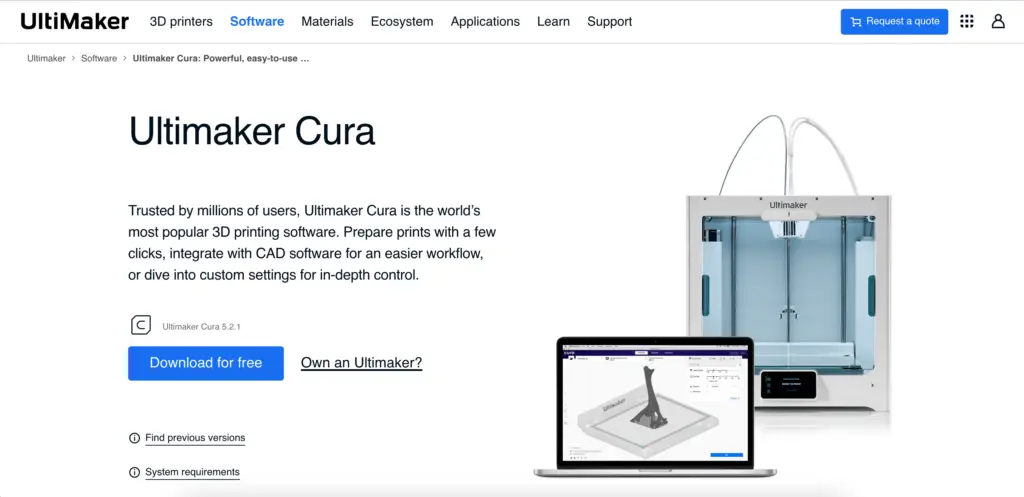Finding the best 3D printing material can be challenging. Some materials have high tensile strength, but they’re too stiff. Others are more flexible, but are weaker.
If you need a strong filament for your project, you might wonder which is your best bet.
The strongest 3D printer filament is PEEK, followed by polycarbonate. However, these materials are not commonly used in hobby 3D printing. More popular options for home use include nylon, PLA, PETG, and TPU. ABS is a popular choice, but it is one of the weakest filaments.
7 Strongest Filaments For 3D Printing
Printing a durable part is the main goal of hobbyist and professional printers alike. However, you might not always need the strongest material.
Here are the characteristics, pros, and cons of the strongest 3D printer filaments.
1. PEEK
The strongest FDM filament, PEEK (polyether ether ketone) is a semi-crystalline thermoplastic known for its excellent mechanical and chemical resistance properties.
As one of the highest-performing thermoplastics, it is typically used in engineering, automotive, aviation, and military industries.
PEEK is different from all other FDM materials because it doesn’t come in contact with water during the manufacturing process. It can also withstand heat and provides excellent adhesion between layers.
The material is also FDA-compliant and suitable to use for food containers and other food-grade applications.
- Our new Filament Printing 101 Course is just for you! Lean how to create perfect professional prints without all the hassle.
- Don't let common mistakes hold you back, click the link to learn more and get ahead now!
Despite these characteristics, PEEK is not a common choice for home 3D printing due to the high cost of the filament. Moreover, PEEK is also difficult to print with, being much more sensitive to calibration mistakes compared to all other 3D printing filaments.
Nevertheless, it can be found in 1.75mm and 2.85mm diameter filaments in spools between 200 and 750 grams.
PEEK has the highest tensile strength of FDM filaments, typically around 105MPa. It can withstand forces up to 12,300 PSI, but it has a rather low shore hardness, between 71 and 75 D.
Pros
- Thermally and chemically stable
- Outstanding strength and rigidity
Cons
- Expensive
- Very prone to warping
- Requires very high printing temperature
- Limited availability
2. Polycarbonate
With a tensile strength of 66MPa, polycarbonate is the second-strongest FDM printing material, but it’s a lot weaker than PEEK. Nevertheless, it has a higher shore hardness, between 90 and 100 D, which is actually greater than PEEK’s.
These characteristics make polycarbonate perfect for consumer-grade FDM printing but also for industries that require tough parts, including bulletproof glass, scuba masks, and riot gear for the police and military.
The main downside of this material is the high printing temperature which often exceeds 250°C.
This limits the types of 3D printers that can handle polycarbonate filament. All is not lost, though, as popular printers like the Ender 3 can reach high nozzle temperatures and print polycarbonate.
Pros
- Flexible but tough
- Heat-resistant
- Good optical properties – ideal for clear parts
Cons
- Requires very high printing temperature
- Prone to abrasion
3. Nylon
Nylon filament is another popular type for a variety of printed items. The term is generic, referring to various synthetic polyamides. They all have similar properties, which is why calibration settings are the same for all nylon filaments.
Strength-wise, this material has a tensile strength of around 63.3MPa and resists forces up to 7,300 PSI. While this is a lot less compared to PEEK, it is still strong enough for the manufacturing of military equipment, including parachutes – thanks to the nylon’s light weight.
This material is also resistant to abrasion, has a low coefficient of friction, and is chemically stable. In addition to its military and industrial use, nylon is a good choice for printing clothes and functional items, such as toothbrushes.
Pros
- Very strong but flexible
- Heat-stable
- Often used as reinforcement
Cons
- Prone to warping
- High printing temperature
- Sensitive to UV radiation
4. PLA
One of the most widely used FDM printing filaments, PLA is short for polylactic acid. This organic material appeals to those concerned about the environmental footprint of plastics, but that’s not the only advantage of this material.
PLA is beginner-friendly. It prints at lower temperatures than most filaments, but it provides incredible strength. It can resist forces of around 7,250 PSI, which is almost as strong as nylon.
The tensile strength and shore hardness are also optimal, 60MPa and around 80 to 85 D, respectively.
This filament type is ideal for a wide variety of projects, from hobby items and collectibles to functional parts and food-grade containers. PLA is very easy to handle and suitable to use with most FDM 3D printers.
Pros
- Affordable
- Biodegradable material
- Doesn’t produce toxic fumes
- Rare warping
Cons
- It has good strength but can lose its properties fast
- Disintegrates naturally over time
5. PETG
Polyethylene terephthalate (PET) is a familiar material. It is generally found in plastic water bottles and other types of plastic packaging. It is also used in the manufacture of everyday items, but in its standard form, it is hard to turn into filament.
This is where PETG steps in, the difference being the glycol added to the formula.
PETG is a chemically-stable, heat-resistant, and impact-resistant material suitable for functional and everyday items designed for outdoor use, or for use in heated environments.
Its tensile strength can’t compete with that of polycarbonate or nylon, but it is easier to print with compared to other heat-resistant thermoplastics.
This doesn’t mean that PETG is easy to print with. This material is notorious for oozing, stringing, and over-the-top bed adhesion.
You may struggle to remove the printed item from the bed, and the part may require more post-processing compared to other popular filaments.
Pros
- Good flexibility and impact resistance
- Satisfactory optical properties
- Chemically stable
- Heat resistant
Cons
- More expensive than ABS or PLA
- Difficult to print with
- Needs post-processing
6. ABS
Similar to PLA in terms of popularity, ABS is actually one of the weakest 3D printing filaments.
It has a tensile strength of around 48MPa and a force resistance of 4,700 PSI. The shore hardness of the material is also lower compared to other rigid filaments, between 55 and 85.
Despite its lower strength, this material is known for its chemical and thermal resistance. It is also easy to smooth and finish with acetone vapor or other undemanding methods.
Smoothing can help you create visually appealing pieces, a factor that makes ABS ideal for miniatures, collectibles, and other artistic prints.
The thermal stability also makes it a winner for engineering and industrial applications, in situations when parts don’t have to withstand external forces.
The main downside, at least for beginners, is the fuzziness of this filament type. ABS is prone to warping and releases lots of toxic fumes.
Pros
- One of the most inexpensive filament types
- Easy to finish with acetone vapors
- Good chemical and thermal stability, once printed
- Resistant to UV radiation
Cons
- Tends to deform due to thermal stress
- Requires the use of bed adhesion enhancers
- Must be printed in a ventilated enclosure
7. TPU
Thermoplastic polyurethane, or TPU, is a version of thermoplastic elastomer filament (TPE). It is one of the most flexible but also one of the strongest filament types, properties that make it ideal for 3D printing rubber-like parts.
Its main advantage compared to TPE is the higher hardness – around 90 to 95 on the A scale – which makes it easier to extrude than TPE.
Tensile strength is also optimal for such a flexible material, and the force resistance is actually higher than ABS (5,076 PSI compared to 4,700 PSI).
Due to its outstanding flexibility, TPU is ideal for objects that need to bounce back to their original shape after being deformed, but also for parts that need outstanding layer-to-layer adhesion.
Pros
- Rubber-like flexibility
- Outstanding layer-to-layer adhesion
- Retains flexibility even at low temperatures
Cons
- Very difficult to print with
- It can’t be smoothed
- Poor bridging
Characteristics Of Strong Filaments
Regardless of their actual strength, all FDM filaments have a few things in common.
Let’s check them out.
Tensile Strength
The main characteristic of strong FDM printing filaments is a tensile strength of around 50MPa or higher.
The tensile strength is a measurement that defines the resistance of a material to breaking under tension, and it is measured in mega Pascal, which is a standard measurement unit of pressure.
While the tensile strength of a material is the sole factor that affects a material’s force resistance, filament manufacturers often use different force resistances (lower than the actual ones) on the filament’s label. This is a common practice to prevent building objects that could break under the applied force.
When printing with a filament, you should consider the PSI value provided by the manufacturer, and not the maximum force resistance that you can calculate by transforming MPa to PSI. A megaPascal equals 145 PSI.
Heat Resistance
Another common characteristic of strong 3D printer filaments is heat resistance. The strongest filaments, such as PEEK, polycarbonate, and nylon, have very high melting points.
They often require a printing temperature above 250°C (and up to 300°C in some cases), which means that you may or may not be able to print them, depending on your printer.
However, once cooled down, the parts have very good heat resistance. This makes strong filaments ideal for printing industrial parts, medical devices, outdoor equipment, etc.
Chemical Resistance
Another common feature of the strongest 3D printing materials is chemical resistance. With few exceptions, these filaments resist harsh acids and corrosive substances, a feature that makes them even more ideal for industrial use.
Some filaments also have good resistance to UV radiation; these materials are ideal for lab and medical equipment or outdoor applications.
Comparison Of Strong Filaments
The table below compares the various strength parameters of common 3D printing filaments*:
| Filament Type | Tensile Strength | Force Resistance | Shore Hardness |
|---|---|---|---|
| PEEK | 105 MPa | 12,300 PSI | D71-D85 |
| Polycarbonate | 66 MPa | 9,800 PSI | D90-D100 |
| Nylon | 63.3 MPa | 7,300 PSI | D85-D95 |
| PLA | 60 MPa | 7,250 PSI | D80-D85 |
| PETG | 53 MPa | 6,300 PSI | D70-D80 |
| ABS | 48 MPa | 4,700 PSI | D55-D85 |
| TPU | 46.7 MPa | 5,076 PSI | A90-A95 |
*Filaments are ranked from strongest to weakest based on their tensile strength. Values in the table are sourced from research papers and various filament brands. They are not absolutes and may vary from one filament brand to another.
FAQs
What color PLA is the strongest?
When it comes to PLA, the filament’s color can influence its tensile strength.
Pale blue is typically the strongest, but also the one with the poorest layer adhesion. Red has the lowest tensile strength, but the best adhesion.
What is the strongest 3D printing infill?
Besides the strength of the filament, a thing to consider if you want to print a strong part is the infill pattern.
The triangular infill is the strongest, followed by grid and honeycomb. Zig-zag patterns are also strong, but not as strong as triangles.
Final Thoughts
PEEK, polycarbonate, and nylon are the three strongest filaments you can use in 3D printing. However, they are also some of the hardest to work with. If you’re a beginner, PLA or ABS might be a better choice. Alternatively, you can practice with PETG before moving to more challenging filaments. No matter what you want to print, we hope this guide can help you find the right material.



